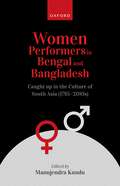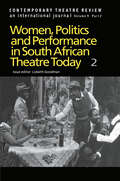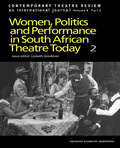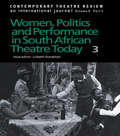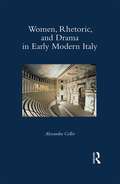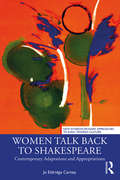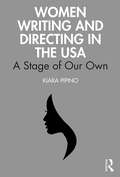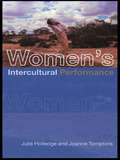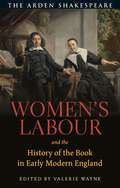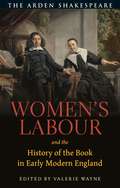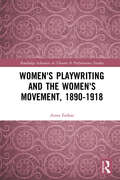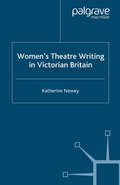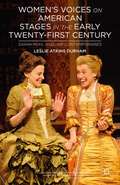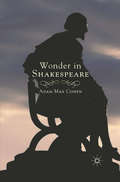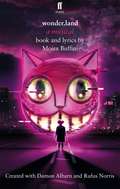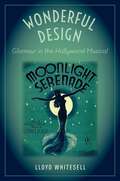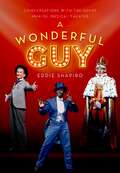- Table View
- List View
Women Performers in Bengal and Bangladesh: Caught up in the Culture of South Asia (1795-2010s)
by Manujendra KunduCovering nearly 225 years, this volume tries to capture a broad spectrum of the situation of women performers from Gerasim Lebedeff's time (1795), who are considered to be the first performers in modern Bengali theatre, to today's time. The moot question is whether the role of women as performers evolved down the centuries. Whether this question will lead us to their subjugation to their male counterparts, producers, and directors has been explored here to give readers an understanding of when, where, by whom the politics began, and, by tracing the footprints, we have tried to understand if the politics has changed, or remains unchanged, or metamorphosed with regard to the woman's question in the performance discourse. We have explored, in this regard, how her body, mind, and sexuality interacted with and negotiated the phallocentric hierarchy. The essays included are on (i) Baiji/Tawaif culture in eastern and western Bengal; (ii) prostitute/'fallen' women/ patita, beshya performers; (iii) IPTA and the Naxalbari movement; (iv) group and commercial/professional theatre of Kolkata; (v) women's position in the theatre of Bangladesh; (vi) Cabaret (with an interview with Miss Shefali) (vii) Jatra; (viii) Baul tradition. (ix) Besides, there are chapters on English, Anglo-Indian, Jew, Nachni performers and the illustrious dancer Amala Shankar, and film-music-dance in general.
Women Performers in Bengal and Bangladesh: Caught up in the Culture of South Asia (1795-2010s)
Covering nearly 225 years, this volume tries to capture a broad spectrum of the situation of women performers from Gerasim Lebedeff's time (1795), who are considered to be the first performers in modern Bengali theatre, to today's time. The moot question is whether the role of women as performers evolved down the centuries. Whether this question will lead us to their subjugation to their male counterparts, producers, and directors has been explored here to give readers an understanding of when, where, by whom the politics began, and, by tracing the footprints, we have tried to understand if the politics has changed, or remains unchanged, or metamorphosed with regard to the woman's question in the performance discourse. We have explored, in this regard, how her body, mind, and sexuality interacted with and negotiated the phallocentric hierarchy. The essays included are on (i) Baiji/Tawaif culture in eastern and western Bengal; (ii) prostitute/'fallen' women/ patita, beshya performers; (iii) IPTA and the Naxalbari movement; (iv) group and commercial/professional theatre of Kolkata; (v) women's position in the theatre of Bangladesh; (vi) Cabaret (with an interview with Miss Shefali) (vii) Jatra; (viii) Baul tradition. (ix) Besides, there are chapters on English, Anglo-Indian, Jew, Nachni performers and the illustrious dancer Amala Shankar, and film-music-dance in general.
Women, Politics and Performance in South African Theatre Today: Volume 2
by Goodman LFirst Published in 1999. Routledge is an imprint of Taylor & Francis, an informa company.
Women, Politics and Performance in South African Theatre Today: Volume 2
by Goodman LFirst Published in 1999. Routledge is an imprint of Taylor & Francis, an informa company.
Women, Politics and Performance in South African Theatre Today Vol 3 (Contemporary Theatre Review Ser. #Vols. 9, Pts. 3.)
by Lizbeth GoodmanThis title available in eBook format. Click here for more information.Visit our eBookstore at: www.ebookstore.tandf.co.uk.
Women, Politics and Performance in South African Theatre Today Vol 3
by Lizbeth GoodmanThis title available in eBook format. Click here for more information.Visit our eBookstore at: www.ebookstore.tandf.co.uk.
Women, Rhetoric, and Drama in Early Modern Italy
by Alexandra CollerSixteenth-century Italy witnessed the rebirth of comedy, tragedy, and tragicomedy in the pastoral mode. Traditionally, we think of comedy and tragedy as remakes of ancient models, and tragicomedy alone as the invention of the moderns. Women, Rhetoric, and Drama in Early Modern Italy suggests that all three genres were, in fact, remarkably new, if dramatists’ intriguingly sympathetic portrayals of and sustained investment in women as vibrant and dynamic characters of the early modern stage are taken into account. This study examines the role of rhetoric and gender in early modern Italian drama, in itself and in order to explore its complex interrelationship with the rise of women writers and the role women played in Italian culture and society, while at the same time demonstrating just how closely intertwined history, culture, and dramatic writing are. Author Alexandra Coller focuses on the scripted/erudite plays of the sixteenth and first half of the seventeenth centuries, which, she argues, are indispensable for a balanced view of the history of drama and its place within contemporary literary and women’s studies. As this book reveals, the ascendancy of comedy, tragedy, and tragicomedy in the vernacular seems to have been not only inextricably linked to but also dependent on the rise of women as prominent stage characters and, eventually, as authors in their own right.
Women, Rhetoric, and Drama in Early Modern Italy
by Alexandra CollerSixteenth-century Italy witnessed the rebirth of comedy, tragedy, and tragicomedy in the pastoral mode. Traditionally, we think of comedy and tragedy as remakes of ancient models, and tragicomedy alone as the invention of the moderns. Women, Rhetoric, and Drama in Early Modern Italy suggests that all three genres were, in fact, remarkably new, if dramatists’ intriguingly sympathetic portrayals of and sustained investment in women as vibrant and dynamic characters of the early modern stage are taken into account. This study examines the role of rhetoric and gender in early modern Italian drama, in itself and in order to explore its complex interrelationship with the rise of women writers and the role women played in Italian culture and society, while at the same time demonstrating just how closely intertwined history, culture, and dramatic writing are. Author Alexandra Coller focuses on the scripted/erudite plays of the sixteenth and first half of the seventeenth centuries, which, she argues, are indispensable for a balanced view of the history of drama and its place within contemporary literary and women’s studies. As this book reveals, the ascendancy of comedy, tragedy, and tragicomedy in the vernacular seems to have been not only inextricably linked to but also dependent on the rise of women as prominent stage characters and, eventually, as authors in their own right.
Women Talk Back to Shakespeare: Contemporary Adaptations and Appropriations (New Interdisciplinary Approaches to Early Modern Culture)
by Jo Eldridge CarneyThis study explores more recent adaptations published in the last decade whereby women—either authors or their characters—talk back to Shakespeare in a variety of new ways. "Talking back to Shakespeare", a term common in intertextual discourse, is not a new phenomenon, particularly in literature. For centuries, women writers—novelists, playwrights, and poets—have responded to Shakespeare with inventive and often transgressive retellings of his work. Thus far, feminist scholarship has examined creative responses to Shakespeare by women writers through the late twentieth century. This book brings together the "then" of Shakespeare with the "now" of contemporary literature by examining how many of his plays have cultural currency in the present day. Adoption and surrogate childrearing; gender fluidity; global pandemics; imprisonment and criminal justice; the intersection of misogyny and racism—these are all pressing social and political concerns, but they are also issues that are central to Shakespeare’s plays and the early modern period. By approaching material with a fresh interdisciplinary perspective, Women Talk Back to Shakespeare is an excellent tool for both scholars and students concerned with adaptation, women and gender, and intertextuality of Shakespeare’s plays.
Women Talk Back to Shakespeare: Contemporary Adaptations and Appropriations (New Interdisciplinary Approaches to Early Modern Culture)
by Jo Eldridge CarneyThis study explores more recent adaptations published in the last decade whereby women—either authors or their characters—talk back to Shakespeare in a variety of new ways. "Talking back to Shakespeare", a term common in intertextual discourse, is not a new phenomenon, particularly in literature. For centuries, women writers—novelists, playwrights, and poets—have responded to Shakespeare with inventive and often transgressive retellings of his work. Thus far, feminist scholarship has examined creative responses to Shakespeare by women writers through the late twentieth century. This book brings together the "then" of Shakespeare with the "now" of contemporary literature by examining how many of his plays have cultural currency in the present day. Adoption and surrogate childrearing; gender fluidity; global pandemics; imprisonment and criminal justice; the intersection of misogyny and racism—these are all pressing social and political concerns, but they are also issues that are central to Shakespeare’s plays and the early modern period. By approaching material with a fresh interdisciplinary perspective, Women Talk Back to Shakespeare is an excellent tool for both scholars and students concerned with adaptation, women and gender, and intertextuality of Shakespeare’s plays.
Women Writing and Directing in the USA: A Stage of Our Own
by Kiara PipinoWomen Writing and Directing in the USA: A Stage of Our Own features interviews with some of the most successful theatre artists currently working on and off Broadway and beyond. The book provides an insight on what it means and what it takes to be a successful female-identifying playwright and director in the USA, where the professional theatrical landscape is still mostly dominated by straight white men. The interviews explore a wide range of themes, including if and how the artists’ female perspective influenced their art, the social and cultural significance of their work, and how theatre and women working in theatre can participate in awakening greater social awareness. Readers will learn about some of the most current and relevant American theatre artists, such as Young Jean Lee, Pam MacKinnon, Dominique Morisseau, Rachel Chavkin, and Martyna Majok. Written for students in directing and playwriting courses, Women Writing and Directing in the USA: A Stage of Our Own features inspirational and informative stories that will help young theatre artists find and pursue their artistic voices.
Women Writing and Directing in the USA: A Stage of Our Own
by Kiara PipinoWomen Writing and Directing in the USA: A Stage of Our Own features interviews with some of the most successful theatre artists currently working on and off Broadway and beyond. The book provides an insight on what it means and what it takes to be a successful female-identifying playwright and director in the USA, where the professional theatrical landscape is still mostly dominated by straight white men. The interviews explore a wide range of themes, including if and how the artists’ female perspective influenced their art, the social and cultural significance of their work, and how theatre and women working in theatre can participate in awakening greater social awareness. Readers will learn about some of the most current and relevant American theatre artists, such as Young Jean Lee, Pam MacKinnon, Dominique Morisseau, Rachel Chavkin, and Martyna Majok. Written for students in directing and playwriting courses, Women Writing and Directing in the USA: A Stage of Our Own features inspirational and informative stories that will help young theatre artists find and pursue their artistic voices.
Women's Intercultural Performance
by Julie Holledge Joanne TompkinsThis is the first in-depth examination of contemporary intercultural performance by women around the world. Contemporary feminist performance is explored in the contexts of current intercultural practices, theories and debates. Holledge and Tompkins provide ways of thinking about and analysing contemporary performance and representations of the performing, female, culturally-marked body. The book includes discussions of: * ritual performance by women from Central Australia and Korea * the cultural exchange of A Doll's House and Antigone * plays from Algeria, South Africa and Ghana * the work of the Takarazuka revue company * the market forces that govern the distribution of women and women's performance. This is an essential read for anyone studying or interested in women's performance.
Women's Intercultural Performance
by Julie Holledge Joanne TompkinsThis is the first in-depth examination of contemporary intercultural performance by women around the world. Contemporary feminist performance is explored in the contexts of current intercultural practices, theories and debates. Holledge and Tompkins provide ways of thinking about and analysing contemporary performance and representations of the performing, female, culturally-marked body. The book includes discussions of: * ritual performance by women from Central Australia and Korea * the cultural exchange of A Doll's House and Antigone * plays from Algeria, South Africa and Ghana * the work of the Takarazuka revue company * the market forces that govern the distribution of women and women's performance. This is an essential read for anyone studying or interested in women's performance.
Women’s Labour and the History of the Book in Early Modern England
by Valerie WayneThis collection reveals the valuable work that women achieved in publishing, printing, writing and reading early modern English books, from those who worked in the book trade to those who composed, selected, collected and annotated books. Women gathered rags for paper production, invested in books and oversaw the presses that printed them. Their writing and reading had an impact on their contemporaries and the developing literary canon. A focus on women's work enables these essays to recognize the various forms of labour -- textual and social as well as material and commercial -- that women of different social classes engaged in. Those considered include the very poor, the middling sort who were active in the book trade, and the elite women authors and readers who participated in literary communities. Taken together, these essays convey the impressive work that women accomplished and their frequent collaborations with others in the making, marking, and marketing of early modern English books.
Women’s Labour and the History of the Book in Early Modern England
This collection reveals the valuable work that women achieved in publishing, printing, writing and reading early modern English books, from those who worked in the book trade to those who composed, selected, collected and annotated books. Women gathered rags for paper production, invested in books and oversaw the presses that printed them. Their writing and reading had an impact on their contemporaries and the developing literary canon. A focus on women's work enables these essays to recognize the various forms of labour -- textual and social as well as material and commercial -- that women of different social classes engaged in. Those considered include the very poor, the middling sort who were active in the book trade, and the elite women authors and readers who participated in literary communities. Taken together, these essays convey the impressive work that women accomplished and their frequent collaborations with others in the making, marking, and marketing of early modern English books.
Women's Playwriting and the Women's Movement, 1890-1918 (Routledge Advances in Theatre & Performance Studies)
by Anna FarkasThe influence of the women’s movement has long been a scholarly priority in the study of British women’s drama of the late nineteenth and early twentieth centuries, but previous scholarship has largely clustered around two events: the New Woman in the 1890s and the suffrage campaign in the years before the First World War. Women’s Playwriting and the Women’s Movement, 1890–1918 is the first designated study of British women’s drama from a period of exceptional productivity and innovation for female playwrights. Both the British theatre and women’s position within British society underwent fundamental changes in this period, and this book shows how female dramatists carefully negotiated their position in the heated debates about women’s rights that occurred at this time, while staking out a place for themselves in an evolving theatrical landscape. Farkas also identifies the women’s movement as a key influence on the development of female-authored drama between 1890 and 1918, but argues that scholarly prioritizing of the "radicalism" of work associated with the New Woman and the suffrage campaign has had a distorting effect in the past. Ideal for scholars of British and Victorian theatre, Women’s Playwriting and the Women’s Movement, 1890–1918 offers a new perspective which emphasizes the complexity of women playwrights’ engagement with first-wave feminism and links it to the diversification of the British theatre in this period.
Women's Playwriting and the Women's Movement, 1890-1918 (Routledge Advances in Theatre & Performance Studies)
by Anna FarkasThe influence of the women’s movement has long been a scholarly priority in the study of British women’s drama of the late nineteenth and early twentieth centuries, but previous scholarship has largely clustered around two events: the New Woman in the 1890s and the suffrage campaign in the years before the First World War. Women’s Playwriting and the Women’s Movement, 1890–1918 is the first designated study of British women’s drama from a period of exceptional productivity and innovation for female playwrights. Both the British theatre and women’s position within British society underwent fundamental changes in this period, and this book shows how female dramatists carefully negotiated their position in the heated debates about women’s rights that occurred at this time, while staking out a place for themselves in an evolving theatrical landscape. Farkas also identifies the women’s movement as a key influence on the development of female-authored drama between 1890 and 1918, but argues that scholarly prioritizing of the "radicalism" of work associated with the New Woman and the suffrage campaign has had a distorting effect in the past. Ideal for scholars of British and Victorian theatre, Women’s Playwriting and the Women’s Movement, 1890–1918 offers a new perspective which emphasizes the complexity of women playwrights’ engagement with first-wave feminism and links it to the diversification of the British theatre in this period.
Women's Theatre Writing in Victorian Britain
by K. NeweyWomen's Theatre Writing in Victorian Britain is the first book to make a comprehensive study of women playwrights in the British theatre from 1820 to 1918. It looks at how women playwrights negotiated their personal and professional identities as writers, and examines the female tradition of playwriting which dramatises the central experience of women's lives around the themes of home, the nation, and the position of women in marriage and the family. The book also includes an extensive Appendix of authors and plays, which will be a useful reference tool for students and scholars in nineteenth-century studies and theatre historians.
Women's Voices on American Stages in the Early Twenty-First Century: Sarah Ruhl and Her Contemporaries
by L. DurhamWomen are at the center of American theatre and have the potential to shape the cultural imagination of theatre-goers as a complex new era unfolds. Sarah Ruhl, one of the twenty-first century's most honored playwrights, is read in concert with her contemporaries whose writing also wrestles with the vexing issues facing Americans in the new century.
Wonder in Shakespeare
by A. CohenIn the first part of this book, Adam Max Cohen embraces the many meanings of wonder in order to challenge the generic divides between comedy, tragedy, history, and romance and suggests that Shakespeare's primary goal in crafting each of his playworlds was the evocation of one or more varieties of wonder.
wonder.land
by Moira BuffiniAly is struggling with all the pressures of being a teenager: family, school, friends and her own insecurities. Then she discovers wonder.land - a mysterious online world where, perhaps, she can create a whole new life. The web becomes her looking-glass - but will Aly see who she really is?A new musical inspired by Lewis Carroll's iconic story, Moira Buffini's wonder.land was created with Damon Albarn and Rufus Norris and premiered at the Manchester International Festival in July 2015 in a co-production with the National Theatre, London, where it transferred in November of the same year.
Wonderful Design: Glamour in the Hollywood Musical
by Lloyd WhitesellAs one of the most beloved and beguiling genres of entertainment, the film musical wears its style ostentatiously. The genre allows for hyperbolic expression, extravagant sonic and visual decor, and extremely stylized forms of movement and performance. By staging a glittering spectacle, by releasing a current of lush sentiment, by unveiling a world of elegance and romance, the film musical woos us with patterns, textures, finesse and sensory display. In this book, author Lloyd Whitesell asks what, exactly, makes film musicals so glamorous. As he argues, glamour projects an aura of ethereality or sophistication by way of suave deportment, sensuous textures, elevated styles, and aesthetically refined effects. Glamour, in other words, is what unites "Cheek to Cheek" from Top Hat and the title song from Beauty and the Beast, each a sonic evocation of luxury, sparkle, grace, and finesse. Whitesell redirects our attention from visual cues like sequins and evening gloves to explore how glamour resides in the sonic. Discussing dozens of musical numbers, analyzing ingenious orchestration, and appraising the distinctive styles of favorite musical stars, Whitesell illuminates fundamental traits of the genre, its aesthetic strategies, and cultural ambitions.
WONDERFUL DESIGN C: Glamour in the Hollywood Musical
by Lloyd WhitesellAs one of the most beloved and beguiling genres of entertainment, the film musical wears its style ostentatiously. The genre allows for hyperbolic expression, extravagant sonic and visual decor, and extremely stylized forms of movement and performance. By staging a glittering spectacle, by releasing a current of lush sentiment, by unveiling a world of elegance and romance, the film musical woos us with patterns, textures, finesse and sensory display. In this book, author Lloyd Whitesell asks what, exactly, makes film musicals so glamorous. As he argues, glamour projects an aura of ethereality or sophistication by way of suave deportment, sensuous textures, elevated styles, and aesthetically refined effects. Glamour, in other words, is what unites "Cheek to Cheek" from Top Hat and the title song from Beauty and the Beast, each a sonic evocation of luxury, sparkle, grace, and finesse. Whitesell redirects our attention from visual cues like sequins and evening gloves to explore how glamour resides in the sonic. Discussing dozens of musical numbers, analyzing ingenious orchestration, and appraising the distinctive styles of favorite musical stars, Whitesell illuminates fundamental traits of the genre, its aesthetic strategies, and cultural ambitions.
A Wonderful Guy: Conversations with the Great Men of Musical Theater
by Eddie ShapiroFascinating, never-before-published interviews with Broadway's leading men offer behind-the-scenes looks at the careers of some of the most beloved perfomers today. In A Wonderful Guy, a follow up to Nothing Like a Dame: Conversations with the Great Women of Musical Theater, theatre journalist Eddie Shapiro sits down for intimate, career-encompassing conversations with nineteen of Broadway's most prolific and fascinating leading men. Full of detailed stories and reflections, his conversations with such luminaries as Joel Grey, Ben Vereen, Norm Lewis, Gavin Creel, Cheyenne Jackson, Jonathan Groff and a host of others dig deep into each actor's career; together, these chapters tell the story of what it means to be a leading man on Broadway over the past fifty years. Alan Cumming described Nothing Like a Dame, as "an encyclopedia of modern musical theatre via a series of tender meetings between a diehard fan and his idols. Because of Eddie Shapiro's utter guilelessness, these women open up and reveal more than they ever have before, and we get to be the third guest at each encounter." A Wonderful Guy brings more fly-on-the-wall opportunities for fans to savour, students to study, and even the unindoctrinated to understand the life of the performing artist.
